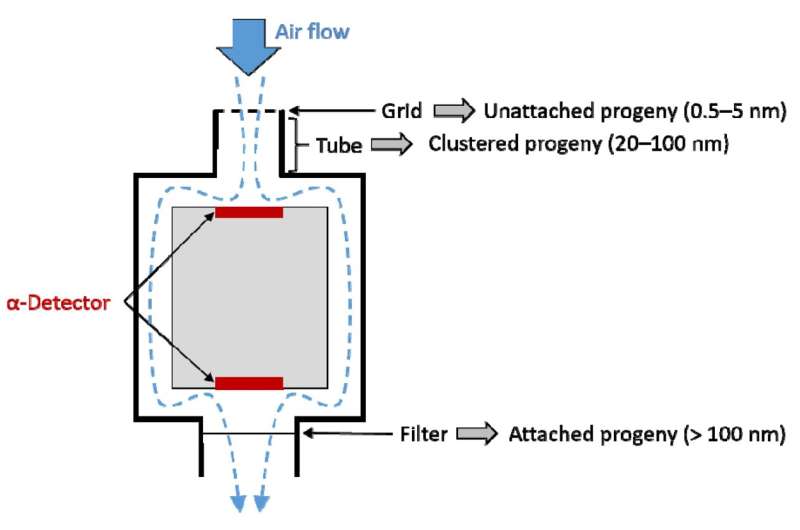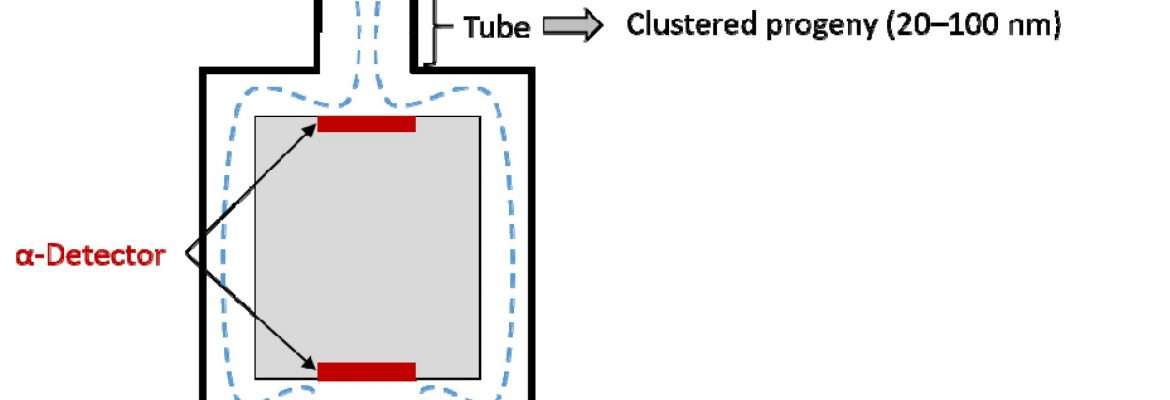Face masks found to reduce radiation exposure

The radioactive noble gas radon has anti-inflammatory therapeutic effects but also contains risks. Radon and especially its short-lived progeny are considered to be responsible for about half of the annual radiation exposure from natural sources and are classified as carcinogenic.
Researchers from the GSI Helmholtzzentrum für Schwerionenforschung now have proven in a paper published in the International Journal of Environmental Research and Public Health that face masks—both FFP2 and surgical masks—strongly reduce lung exposure and thus the dose of radiation.
This can provide a simple and cost-effective method of protection for people who are exposed to higher levels of radon and its progeny, such as in workplaces, for example in radon galleries or radon baths.
The research project, with the participation of GSI scientists Annika Hinrichs, Claudia Fournier, Gerhard Kraft and Andreas Maier, was conducted as part of the “GREWIS-alpha” consortium. GREWIS, a German acronym, stands for “the genetic risks and anti-inflammatory effect of ionizing radiation.” The word “alpha” stands for the densely ionizing alpha particles that are emitted when radon and its daughter nuclei decay.
Radiation biologist Professor Claudia Fournier from the Biophysics Department of GSI is the overall coordinator of this joint project, in which GSI is cooperating with TU Darmstadt, Goethe University Frankfurt, and the Friedrich-Alexander University of Erlangen-Nuremberg.
“GREWIS-alpha” is intended to more and more refine questions concerning radon and provide new insights into very different aspects, for example regarding the physical and biological effects, but also regarding the damage after radon exposure and possible ways to better control and minimize radiation risks. Here, the current publication provides important insights.
The short-lived progeny of the naturally occurring radioactive noble gas radon attach to other particles or droplets forming larger aerosol particles, adhere to the lungs when inhaled, and deposit their decay energy there, damaging sensitive lung tissue. Radon itself is directly inhaled. These progeny are considered responsible for more than 95% of the total effective dose and are, together with radon, classified as carcinogenic for lung cancer.
Consequently, filtration of the progeny could significantly reduce the dose to the lungs. In the recent study, the researchers investigated the filtering properties of FFP2 masks and of surgical masks (II R) for radon and its decay products.
For the study, the masks were attached to a measurement device, which enabled determination of the different size fractions of radon progeny, ranging from very small decay products (so-called unattached progeny) to medium-sized decay products (so-called clustered progeny). In parallel, it measured the radon activity concentration during experiments. By comparing background measurements without mask and experiments with masks, the percentage of retained small decay products was determined for FFP2 (98.8 %) and II R masks (98.4 %). For medium-sized decay products, the retained fraction was 85.2 % for FFP2 and 79.5 % for II R masks. Radon was not filtered.
The results provide solid guidance that facemasks are effective in filtering radon progeny and will significantly reduce the concentration of radon progeny in the respiratory system, whereas radon is not filtered. Nevertheless, filtering can lead to lower doses to the lungs during radon exposure and thus to a reduced risk for lung cancer.
Besides general, natural occurring exposure of the public, this is also important for occupational exposure, for example in radon galleries or radon baths. The radioactive element radon is used in the form of baths or inhalations in these healing caves and baths to treat many patients, and it has met with success.
The pain-relieving effects of low-dose radon therapies for patients suffering from painful chronic inflammatory illnesses have been known for centuries. These therapies are used for diseases of the locomotor system such as rheumatism and arthrosis, as well as diseases of the respiratory system and the skin, including neurodermatitis and psoriasis.
In these treatment facilities, enhanced levels of radon and progeny can be measured. This makes efficient ventilation necessary, but as the current findings show, the wearing of facial masks may also be an easy and cost-efficient method for dose reduction in the staff. Additionally, it can also reduce the exposure to airborne particles in general.
More information:
Annika Hinrichs et al, Radon Progeny Adsorption on Facial Masks, International Journal of Environmental Research and Public Health (2022). DOI: 10.3390/ijerph191811337
Journal information:
International Journal of Environmental Research and Public Health
Source: Read Full Article
